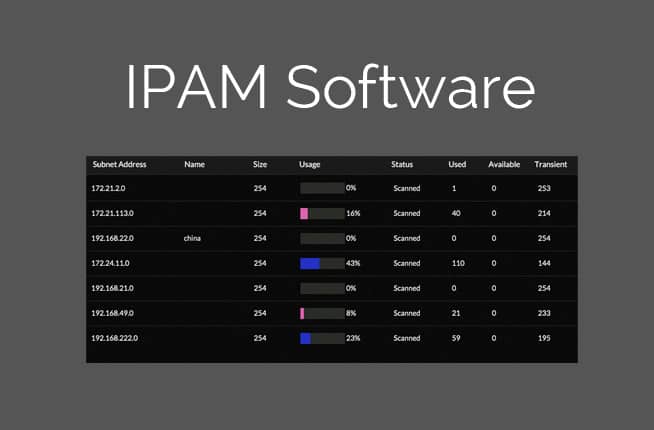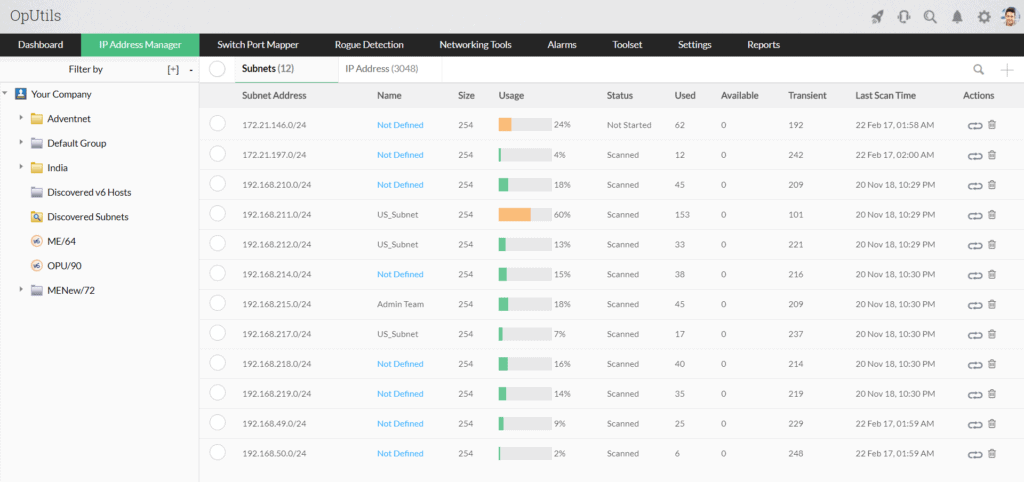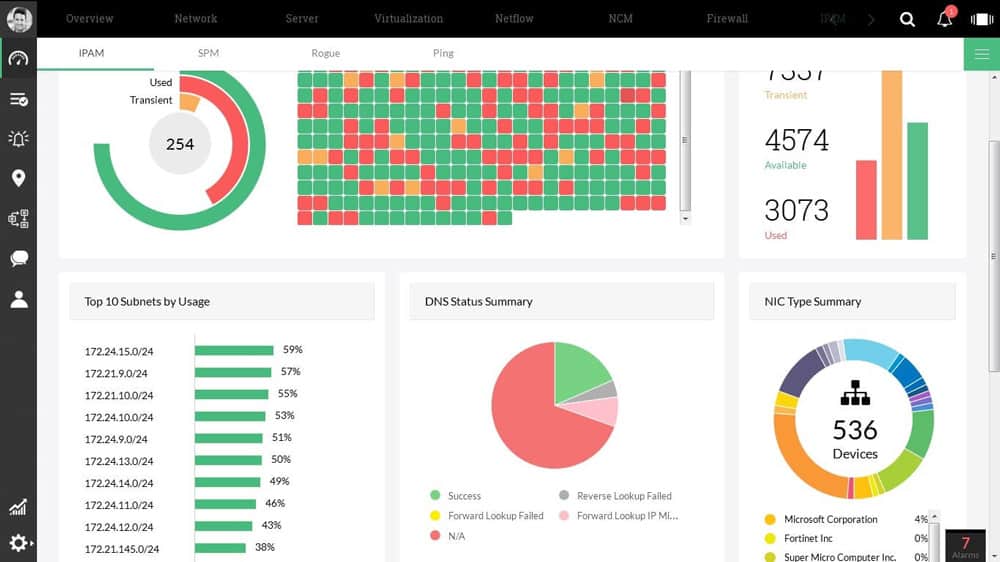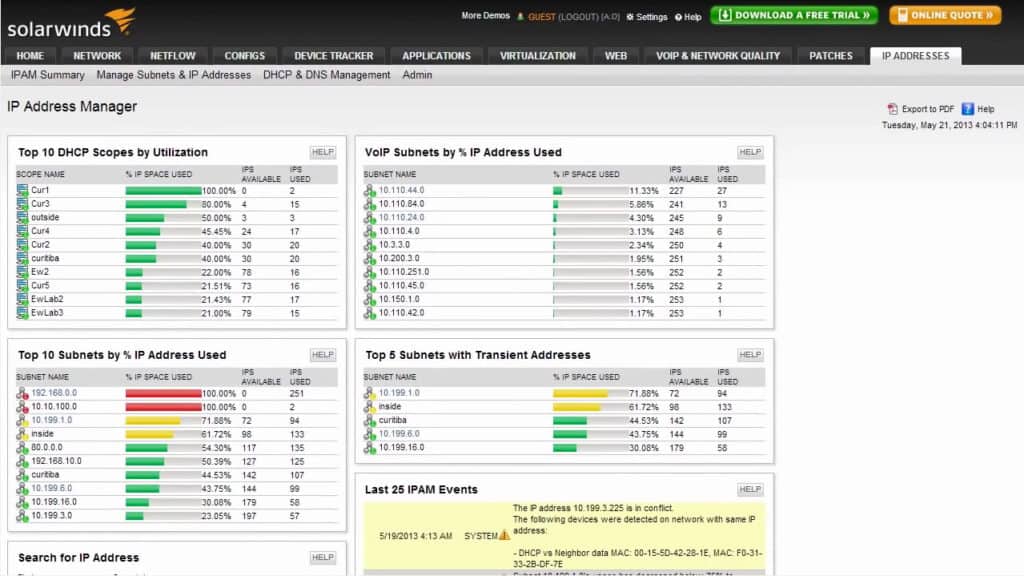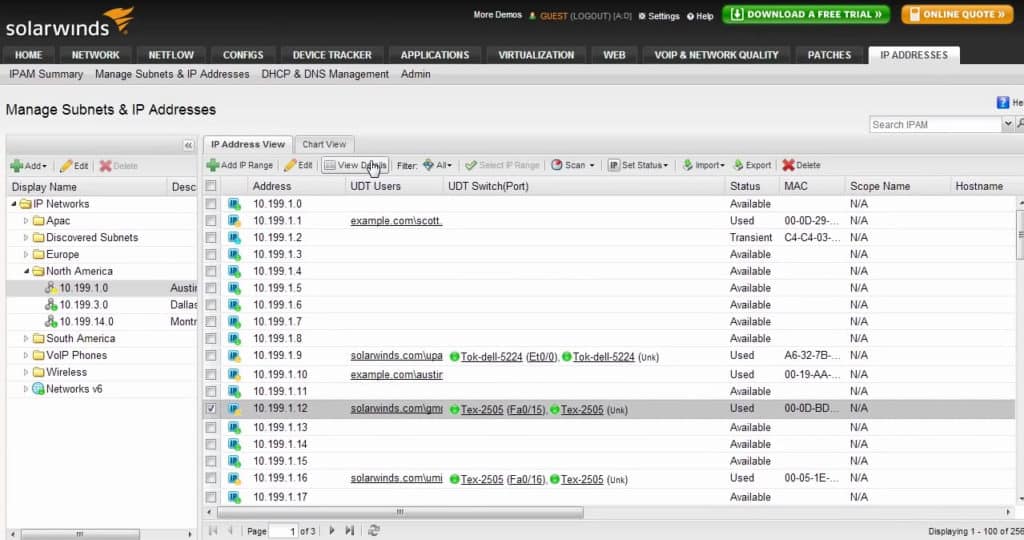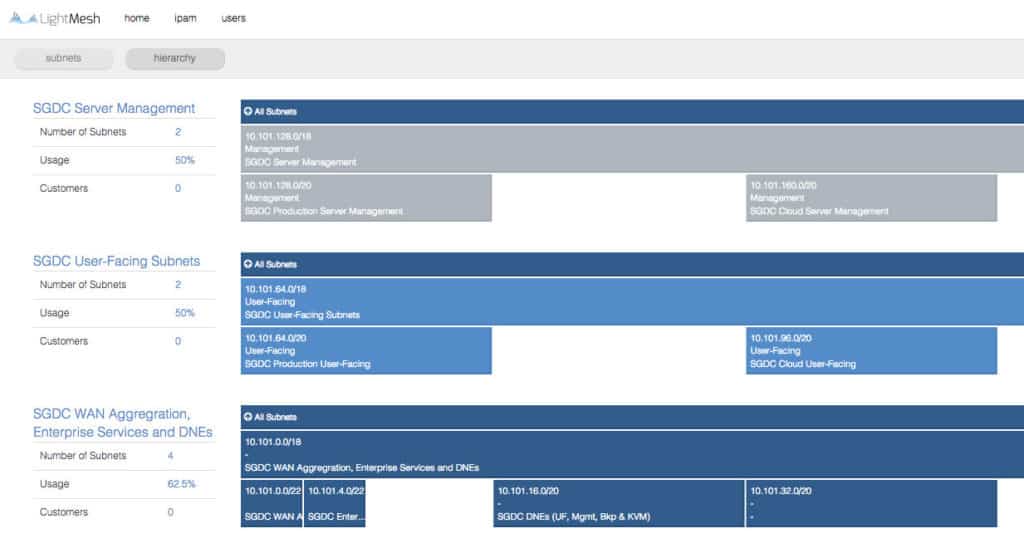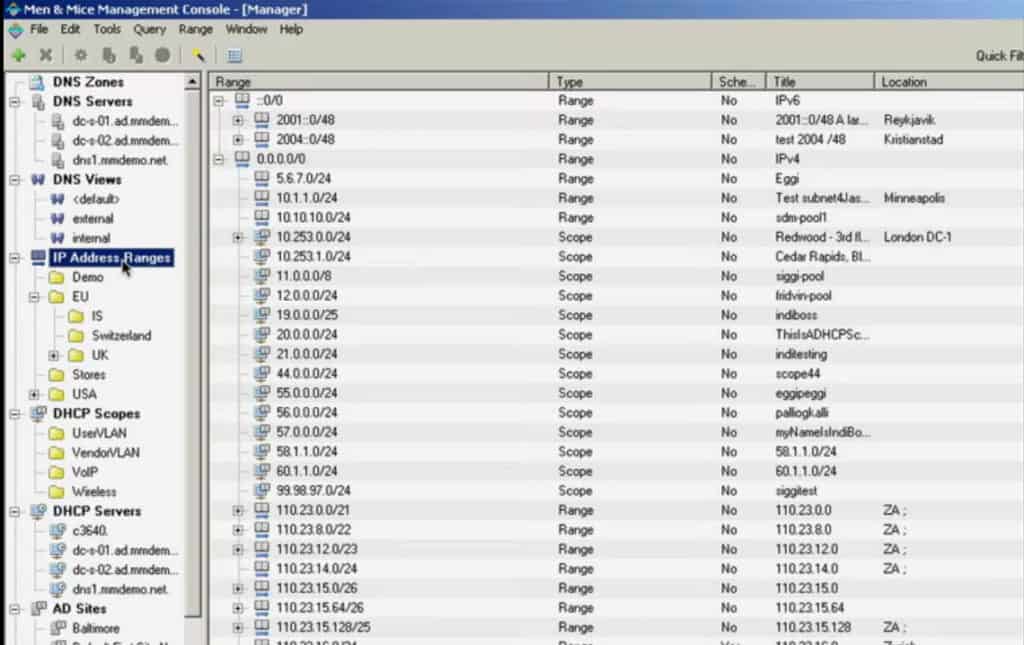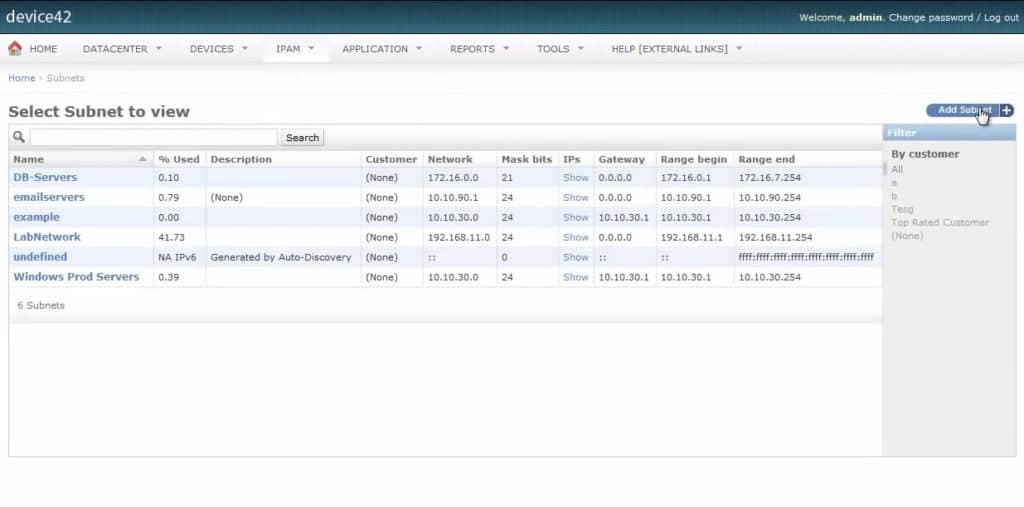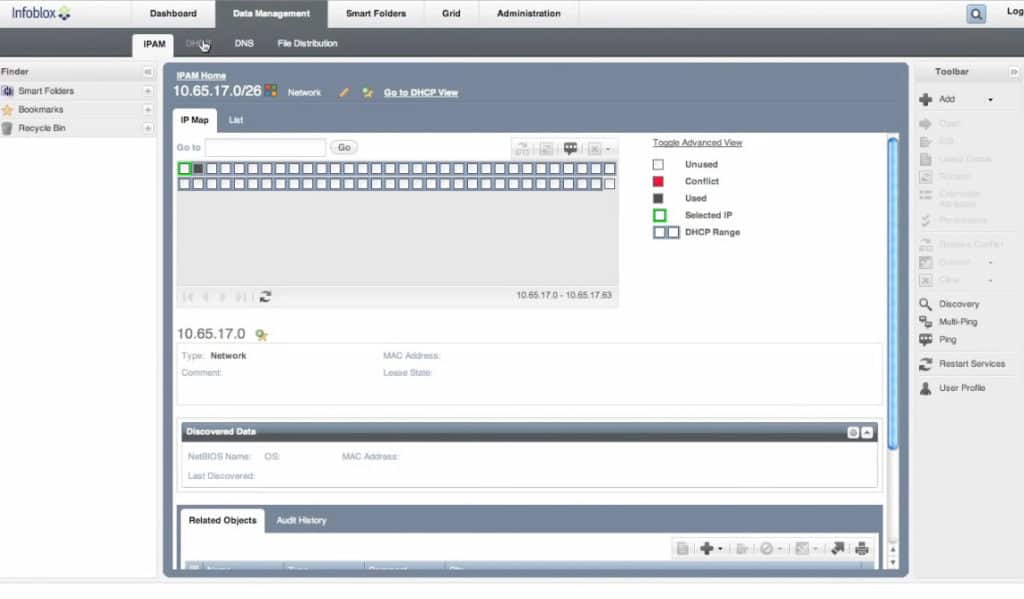IPAM, IP Address Manager or sometimes interchangeably IP Address Management, is software that aids in the act of managing IP addresses in use, as well as tracking IP Addresses on a network.
IPAM Software assists admins in handling the triage of DDI – DHCP, DNS, and IP addresses. Any network with more than ten users can quickly become quite confusing, particularly when adding in variables such as printers or other independent devices, folks bringing their cell phones into work with Wi-Fi enabled that then connect to the network, and so forth!
Here is our list of the best IPAM tools for IP address tracking and management:
- ManageEngine OpUtils – FREE TRIAL A combined IP address manager and a switch port manager. This tool also provides a network port scanner. Available for Windows Server, Linux, and AWS. Download a 30-day free trial.
- ManageEngine IPAM Add-on – FREE TRIAL This is the OpUtils package when added onto the OpManager network and server monitoring tool. Available for Windows Server, Linux, AWS, and Azure. Download a 30-day free trial.
- SolarWinds IP Address Manager This IPAM is packaged together with DHCP and DNS servers to provide a full DDI solution that provides automated scanning and alerts for address issues. Runs on Windows Server.
- BT Diamond IP A managed service that provides the server to support the IPAM software plus the staff to manage the system. Cloud-based.
- BlueCat IPAM This DDI solution provides options to create an overlay network and merge sites across the internet. Runs over a hypervisor.
- LightMesh An IPAM service that also includes an access rights management system, which makes it suitable for SASE implementations. This is a cloud-based system.
- Men and Mice A cloud-based DDI that provides DHCP, DNS, and IP address management.
- GestióIP This package creates a unified IP address space for multiple sites and cloud services. Free for installation on Linux or a SaaS package for a fee.
- TCPWave This cloud-based IP address manager works with your on-site DHCP and DNS servers.
- Device42 This IT asset management and system monitoring package includes an IPAM. Runs on a cloud platform or a VM.
- Infoblox Trinzic IPAM Offered as an appliance but also available as a virtual appliance or a SaaS platform, this DDI package can create a range of hybrid network solutions.
Sometimes it's sufficient to use a bare-bones solution like a spreadsheet or similar to keep tabs on user addresses and reservations, but even for smaller organizations it's easy to see how this can fall short. Forgetting to update the list, or simply having several admins referring to the list with different plans or methods, all can create chaos and conflicts. Worse yet, it's quite easy for something small like this to cause significant outages or downtime of critical systems!
As more devices pile onto the network, it is more and more likely that things will become disorganized, especially when attempting to handle it manually. IP addresses change or need changing, IPs get spread out and create wasted ‘sprawl', and altogether become unnecessarily confusing. IP address management also helps with Subnetting and ensuring that you keep track of all subnet IP Addresses that are assigned out a certain subnet.
Fortunately, there are many options, both paid and free, that offer a wide range of solutions to this very issue that are scalable to almost any environment. So far we've mentioned many of the shortfalls of manual IPAM and why it's important, and below are a handful of ways that IPAM software can really make this part of a network admin's life a lot easier.
Many IPAM solutions offer a gambit of features that will swiftly remedy these issues while, at the same time, preventing future ones!
Automatic discovery and analysis of network topography can quickly assess addresses used, ferret out unnecessary sprawl, find and resolve overlaps, all within mere minutes from a single system. Looking forward, IPAM software can help ease the growing pains of an expanding network, or aid in transitioning fully from IPv4 to IPv6, for example. Some options for especially large environments include hardware appliances that perform incredible feats of IPAM due to their dedicated nature!
Here's the Best IP Address Management (IPAM) Tools & Software of 2024:
Below is a list of a range of programs that do precisely what's above, and sometimes more, including both paid and free, as well as a few open-source selections to boot!
What should you look for in an IP address management tool?
We reviewed the market for IPAM systems and analyzed options based on the following criteria:
- Network scans on demand and on a schedule
- Integrated DHCP and DNS server or data exchange facilities
- Possibility to export output in CSV format
- The ability to identify rogue devices
- IP address conflict detection
- A free trial or a demo option for a cost-free assessment opportunity or a free tool
- Value for money from an IPAM that is offered at a fair price or a free system
With these selection criteria in mind, we looked for IP address management systems and we included some free tools.
1. ManageEngine OpUtils – FREE TRIAL
ManageEngine OpUtils is a great tool that Helps you manage and maintain your IP Address Space quickly and easily from a centralized dashboard. OpUtils gives you the option to manage both IPv4 and IPv6 address ranges to aid in network administration and IP tracking of devices and such. This tool scans your address ranges to give you status updates for IP connected devices, servers and computers on your network.
Key Features:
- Automatic Scanning of networks, subnets and ranges of your choice
- IP history to track & audit changes within your network
- Reports and alerts/notifications
Unique Feature:
Makes it easy to manage IPs and switch ports while detecting rogue connections.
Why do we recommend it?
ManageEngine OpUtils monitors your IP addresses and ports in real-time. Also, it comes with 30+ tools with the option to further add custom SNMP tools.
Who is it recommended for?
Another great choice for network engineers of large organizations. They can use this tool for troubleshooting connectivity issues.
Pros:
- Supports IP management and physical switch port monitoring
- Offers built-in troubleshooting tools to help
- Supports CISCO and SNMP tools to help configure, administer and diagnose issues
- Better suited for sysadmin
Cons:
- Offers many advanced features and options, not suited for small home networks
To get a full overview of this great product, have a look at their website below and get started with a 30-day free trial.
2. ManageEngine IPAM Add-on – FREE TRIAL
ManageEngine has recently jumped into the IP address management software realm as well with their IPAM add-on for their OpManager software.
They, as many other software solutions in this list, provide all the various IP address-related information that you would need at your fingertips in one place, including but not limited to DNS FQDN, Mac address, system state and name, device type and if integrated with their switch port mapper add-on, which switch port its connected to.
Other features that are included are Active Directory integration with computer accounts which subsequently can pull in additional information from active directory including GUID, last logon time, OS name and version and a lot more information.
On top of AD integration, you have the functionality of ‘Historical' IP address look-up for finding IP address information on a certain day and time for further investigate issues that arise.
Why do we recommend it?
Offers real-time monitoring and troubleshooting through its centralized console. Also, this add-on discovers IPs and ports quickly.
Who is it recommended for?
Helps network admins to monitor and troubleshoot any network issues related to ports and IP addresses.
Pros:
- Designed with large networks in mind
- Offers a suite of tools that provide WoL, IP address management, and physical switch port mapping
- Gathers hostname, device status, and MAC address alongside IP address scans
- Identifies new machines via autodiscovery, great for larger deployments
- Available for both Windows server as well as Linux
Cons:
- ManageEngine is a large monitoring platform that offers a host of tools and features that may take time to fully explore
The package starts at $595 and additional cost for IPAM add-on. You can begin by downloading the 30-day free trial of OpManager.
More Info: https://www.manageengine.com/network-monitoring/ipam-spm-plugin.html
3. SolarWinds IP Address Manager
The SolarWinds IP Address Manager offering is one of the most broadly robust for both enterprise level as well as smaller network environments. The IPAM beautifully and natively integrates with several other SolarWinds offering, creating an even more powerful and robust suite of software if a network environment includes those tools.
The visual interface is excellent and swiftly discovers and arranges topography of devices with surprising accuracy, as well. Predictably, all the other basic functionality is included for avoiding IP sprawl, bring-your-own-device (BYOD) management, DHCP/DNS management and port forwarding, and plenty more. Additionally, SolarWinds' IPAM has excellent historical logging and archiving, making it easier to research ongoing issues or view network trends.
Also of note is the granular way in which admin permissions and network domains can be divided up. There's no need to worry about having to give too much, or struggle with giving too little, permission to any one admin or group of admins.
It's remarkably easy to subdivide the network into manageable portions and, from there, assign different admins or admin groups different levels of permissions and command availability, which drastically can ease managing a large multi-building network with several IT departments working on a WAN.
Why do we recommend it?
It comes with a ton of IP tracking features like automated IP tracking, address alerting, and more. At the same time, it's also simple to use and highly customizable.
Who is it recommended for?
A great choice for large organizations with thousands of IP addresses.
Pros:
- Comprehensive DDI package, great for small and large networks
- Can track addressing issues such as IP conflicts, misconfigurations, and subnet capacity limitations
- Lightweight – runs on a simple Windows Server deployment
- Features subnet allocation tools to save tons of time on address allocation and planning
- Templated reports can easy to execute and customizable
Cons:
- Not designed for home users, this is an in-depth networking tool built for IT professionals
Access a 30-day free trial to determine your network requirements.
4. BT Diamond IP
BT Diamond IP is unique in that they offer a full-on, fully-staffed managed solution. This may be ideal for those with a small IT department, for groups who don't really have a centralized and dedicated IT staff, or those who have an IT staff that is already just too busy taking care of everything else!
Moving the workload of IPAM solutions to an external company with a full staff can save a great deal of time and effort while also, considering the cost of hiring an extra admin or two in comparison to BlueCat's service license, save a lot of money as well.
Not an ideal solution for a network with very specific or ongoing needs or an environment that already has IPAM under control without an excess of workload to go with it.
Why do we recommend it?
Streamlines the management of both IPv4 and IPv6 addresses across their entire lifecycle. It can also be a handy tool for managing DNS and DHCP servers across multiple vendors.
Who is it recommended for?
Works well for organizations that use common DNS/DHCP servers, like Microsoft, BIND, and Cisco.
Pros:
- Offers the product as a tool or a managed service, good for resellers and companies who wish to outsource IP management
- Supports multi-cloud environments for larger networks
- An ideal choice for organizations that rely heavily on cloud-based services
Cons:
- Must contact sales for pricing
- Manage service is likely more costly than self-management
Price: No trial, Must contact for price
More Information: http://www.globalservices.bt.com/us/en/products/diamondip
5. BlueCat IPAM
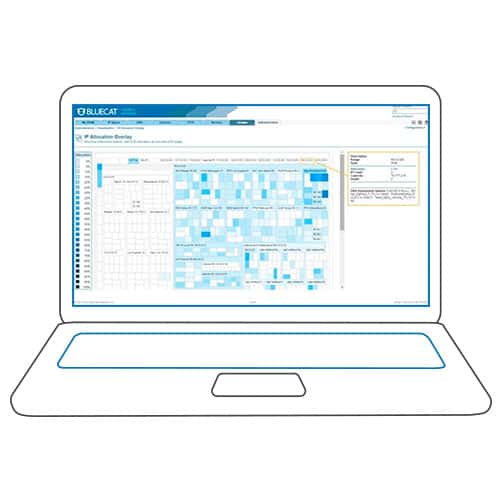
BlueCat's automatic discovery is particularly quick and accurate, snagging all the usual data such as IP Address, DNS/DHCP, DHCP lease, host records, and physical addresses, plus more!
This software has a strong lean to enterprise environments however, especially the quirky situations in which DNS or IP configurations need to be constantly and quickly changed and adjusted – this pushes it strongly towards a web-service or data-center role, but it more than pulls its weight in the right place.
Why do we recommend it?
Helps to plan and track IP addresses easily on your network. Plus, it also analyzes your DNS traffic to minimize risk.
Who is it recommended for?
Ideal for growing organizations, as it is highly scalable.
Pros:
- Interfaces from the web, making management accessible from anywhere
- Can easily tracking DHCP lease times, used IP addresses, and device hostnames with little configuration
- Can be deployed physically as well as virtually
Cons:
- Must contact sales for pricing
- The interface needs improvement, could be easier to save configurations and navigate menus
- More knowledgebase articles would be helpful for new users
Price: Evaluation license available, around $14,000 after that for standard license
Evaluation license: http://go.bluecatnetworks.com/evaluation-request
6. LightMesh
LightMesh's IPAM software boasts much of the same functionality as many other software options but it truly shines in regards to the UI. While normally this isn't something to exactly base a software purchase on it really does make the difference in this case.
Having data and information available is keenly useful, but having it presented in a way that is intuitive is far more important, and that's where LightMesh does its job well.
The GUI is well designed and the intelligent graphing and displays help immensely in filtering out unnecessary noise to make sure only the more important information is being relayed at any given time.
Why do we recommend it?
This tool comes with a calculator and visual planner for subnetting. Also, it makes it easy to maintain all endpoints.
Who is it recommended for?
Works well for large organizations that want to simplify and automate IPAM.
Pros:
- Visually displays devices and subnet allocations neatly through a graphing feature
- Supports team environments with separate user accounts and permissions sets
- Can audit actions within the product for better accountability and troubleshooting
- Better suited for larger enterprise networks or MSPs
Cons:
- Smaller networks might not be able to take advantage of the team features
Price: Online tour, no trial; $200 per Month for 2/User and 10,000 IP's.
More Information: https://ipam.lightmesh.com/ipam
7. Men and Mice
Men and Mice performs most of the basic IPAM needs with one strong emphasis – Active Directory!
Any environment that leans heavily on AD and its API will benefit from a solution that is sensitive to this particular facet of a network – doubly so considering Men and Mice's scripting function which can beautifully speed up configuration and setup, as well as provide swift resolution via scripts for troubleshooting and outages.
Why do we recommend it?
Integrates well with DNS and DHCP servers. Plus, it provides extensive information about subnets, routers, IPs, and more.
Who is it recommended for?
Ideal for network administrators who want to collect critical information about their networks for analysis and troubleshooting.
Pros:
- Offers DNS and DHCP monitoring and management for more centralized control of your networks
- Viable management solutions for MSPs
- Is able to track addressing issues in cloud and hybrid environments
- Browser-based dashboard makes the product more accessible than similar tools
Cons:
- The interface could be made more user-friendly and use more visualizations
- Integrations into some cloud providers can be time-consuming
Price: Free trial; must contact sales for quote
Download link: https://www.menandmice.com/free-trial
8. GestióIP
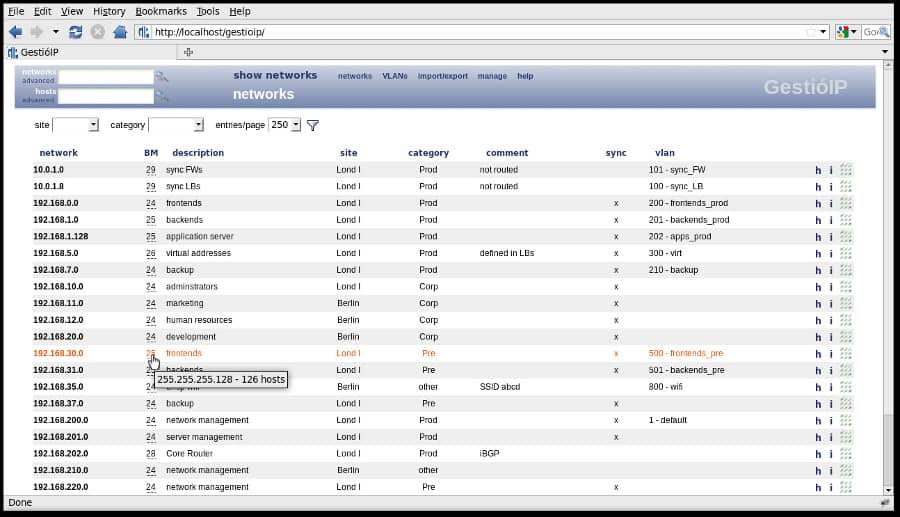
GestióIP, with its quirky accented name, is an excellent solution considering it's completely free!
It supports a strong range of automatic discovery and mapping all from a web-based interface, making it easy to both view and manage your IPAM needs from anywhere on your network, if not remotely.
Furthermore, GestióIP has a unique search-engine based method for network searching which gives an unusually powerful ability to perform intelligent searches.
Why do we recommend it?
It offers a powerful auto-discovery feature that saves time and effort. Additionally, its search and filter functions extend to the hosts and networks as well.
Who is it recommended for?
A good choice for large organizations looking to automate their IPAM activities.
Pros:
- Supports multiple site monitoring
- Installs on a Linux host – or available as a SaaS
- Easy to use and get started
Cons:
- Better for small to medium environments
- Integrations into some cloud providers can be time-consuming
Price: Free
Download link: https://sourceforge.net/projects/gestioip/files/gestioip_3.2.tar.gz/download
9. TCPWave
TCPWave's strength comes in the form of how endlessly scalable the technology is.
Built upon a non-BIND base means that the IPAM methodology is somewhat different from usual while still bringing in the same features and functionality of other software and hardware solutions alike.
Some options for IPAM will have a hard time making the jump from small office to big office, much less big office to a dozen datacenters, but TCPWave is more than capable of taking the leap with ease.
Why do we recommend it?
Automates DNS cloud provisioning in private cloud environments. It is also cost-effective and scales well with your growing cloud footprint.
Who is it recommended for?
Ideal for organizations that want to integrate with some of their existing tools like ServiceNow. It also works well with cloud platforms like AWS, Azure, and GCP.
Pros:
- Flexible cloud-based manager
- Easily syncs with your DHCP and DSNs servers
- Has a simple admin dashboard
Cons:
- Can take time to fully explore all features
Price: No trial, can sign-up for demo, must contact sales for quote
Demo link: http://www.tcpwave.com/contact-us/
10. Device42
Device42‘s approach steers away from general network IPAM services and more to handling large arrays of clustered machines and server racks. In particular it features automated discovery and organization of rack-based environments – this means a huge savings in regards to time for setting up proper topography.
Many IPAM solutions will discover devices but don't always lay them out and connect them just right in regards to mapping, and that's where Device42 excels.
Furthermore, it has native functionality for generating QR codes to facilitate easy identification for scanning and moving hardware about quickly!
Why do we recommend it?
Device42 uses simple API calls to identify the next available IP address for a requesting device. It is also agentless and you can assign IP addresses automatically using a script.
Who is it recommended for?
Works well for system admins of all sized organizations to track and manage their IP addresses.
Pros:
- Can produce automatic topology maps as well as dependency mapping
- Offers a unique rack-level visualization to help on-site technicians map physical infrastructure to certain services
- Designed to scale in enterprise environments
Cons:
- Initial configuration can be complex and time-consuming
- Would like to see it easier to create custom affinity groups
Price: Free trial, $1,499 for up to 1000 IP's.
Download link: http://www.device42.com/download/
11. Infoblox Trinzic IPAM
This particular choice is one of the many hardware options out there – they come with a hefty price tag but for a very good reason.
The devices hook directly into your network and are interfaced with via web console and perform much the same tasks as any software or server based IPAM but do so with an even greater reliability.
Hardware appliances like this free you from the constraints of client configurations and software installations – you need only drop it into your network's hardware setup and load up the interface to get your IPAM solution under way.
The only real downside is that updates are sometimes a bit more cumbersome with hardware solutions, and it does introduce another hardware-level point of failure into a network setup.
Why do we recommend it?
Trinzic oosts the performance of your DNS and DHCP servers. Moreover, it also connects IP addresses with end-user identities.
Who is it recommended for?
A good choice for organizations that have a mixed hybrid and multi-cloud infrastructure.
Pros:
- Can automatically identify unmanaged devices, great for MSPs cleaning up new client infrastructure
- Supports LDAP Active Directory integration
- Can create customized workflows for repeat administrative tasks
- Generous 60-day trial period
Cons:
- The interface isn’t as intuitive as leading tools on the market
- Reporting is considered an add-on, and not included in the base product
Price: Starts at $7,145 and goes up from there.
More Information: https://www.infoblox.com/products/ddi/
Open-Source Alternatives
NiPaP – Neat Address Planner
This particular software is quite interesting as it began as a provider-level IPAM solution used internally by a major European service provider!
This should suggest right away just how powerful and robust it can be – the flip side is that, due to being based on a custom internal piece of software, some parts of it are a bit more kludge-y than others, so to speak.
None the less, it supports a wide range of features written in Python and is splendidly well documented.
The develops even proudly proclaims itself to be the “best open-source IPAM in the known universe!”
Until we come into contact with other life in the universe with powerful IPAM software, we'll just have to take their word for it.
Price: Free
Download link: https://github.com/SpriteLink/NIPAP
IP Plan
This is one of those programs that received a great deal of development and effort that eventually tapered off – many folks will say this happens in open-source readily for one of two reasons:
Something superior branches off or, in some cases, the program is simply “done!”
IP Plan falls into the latter category – it's simple and bare-bones in regards to interface, but is virtually error free and perfect in execution.
It's a bit restricted in its dependence on *NIX environments, but runs in a staggering range that reaches to Mandrake and even further.
Price: Free
Download link: https://sourceforge.net/projects/iptrack
Free & Paid IPAM Tools FAQs
How does an IPAM system work?
An IPAM system works by providing a central repository for IP addresses and related network information. It can automatically discover and track IP addresses and related network devices and provide real-time visibility into IP address usage, availability, and utilization. It also automates IP address allocation and management, reducing the risk of IP address conflicts and network disruptions.
What are some popular IPAM tools?
Some popular IPAM tools include:
- SolarWinds IP Address Manager
- BlueCat Address Manager
- Infoblox IPAM
- Men & Mice Suite
- GestioIP
How does an IPAM system integrate with DHCP?
An IPAM system can integrate with DHCP by providing centralized management of DHCP scopes, leases, and other DHCP-related information. It can also automate DHCP configuration and monitoring, reducing the risk of IP address conflicts and network disruptions.
How does an IPAM system help with IP address utilization?
An IPAM system can help with IP address utilization by providing real-time visibility into IP address usage and availability. It can also automate IP address allocation and management, optimizing IP address utilization and reducing the risk of IP address conflicts.

